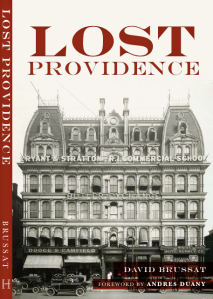
Recently completed Gaillard Center, in Charleston, S.C. (DMSA)
The headline on this post is supposed to refer to Gertrude Stein’s famous line about Oakland – “There’s no there there.” The Huffington Post has an essay that tries to show, rather absurdly, that Stein did not mean to denigrate her native town but rather to express a “painful nostalgia.” She returned 45 years after leaving and was unable to find the house she grew up in, surrounded by orchards and farms. It had been turned into a residential development with hundreds of houses. She wrote:
[W]hat was the use of my having come from Oakland it was not natural to have come from there yes write about it if I like or anything if I like but not there, there is no there there.
Did she refer to Oakland itself, which had grown from 35,000 to 300,000 since she had left, or to her homestead? It’s hard to tell. The prose is, shall we say, modernist, which places no high regard on meaning, at least not in the direct sense understood by most readers. It seems to me that she was referring to Oakland – perhaps as seen through the context of her loss of home.

Art on Oakland/Berkeley border. (HP)
In the Huffington essay “Gertrude Stein’s Oakland,” Matt Werner writes that one of the themes of his interviews involved “a notion of disenfranchisement similar to what Stein experienced by returning to a changed city.” The artists that he interviewed had created works of public art intended to generate context for the “no there there” city. One photograph shows a sculpture of the word “THERE” rendered in flat silvery sans-serif letters and propped up near a street that enters the city from Berkeley. … Uh-huh. Okay. Let’s not go there.
Like many cities, Oakland would be a nicer place with more there there if not for a period of many decades in which mounting assaults upon historical context was the norm in cities. My book Lost Providence, to be published in spring 2017, deals precisely with what happens when a policy of contra context is embraced by city planners. Which brings me to an excellent new essay on the Future Symphony Institute blog, which pursues the same theme from the other direction. But it’s really all about the amount of unnecessarily cogitation that must often be done to design a building that fits into its context, now that that’s considered (by some) to be okay.

The institute’s blog has published “Designing Contextually in a Place Without Context,” by Steve Knight, of David M. Schwarz Architects, a firm that masterfully designs new traditional architecture and is headquartered in the District of Columbia. Knight describes the difficulties facing architects charged with designing buildings in locations that offer few obvious hints about how the building’s context should be interpreted. Fitting into a site whose there is actually there is not necessarily simple. Doing so with no there there is much harder. Knight writes:
Understanding context means more than delving into architectural guidebooks or looking at surveys and photographs of a site. It means that we have to go beyond the immediate boundaries of a building plot and look at the larger influences of a neighborhood, a city, or even the region in which a project is located. And when all of that study doesn’t reveal a particular feel or vibe, it likely means we haven’t dug deep enough. We need to look farther and wider to discover the context. This further study often requires talking to people in the community, looking into the history and tradition of the particular building type we find ourselves designing, studying users’ behavior, and asking users about their motivations, desires, and expectations. Above all, determining context requires a level of deference and curiosity.
Very true. Essentially, however, Knight is saying that without more obvious cues as to context, architects must reach out for secondary and tertiary sources of meaning – sources less likely to be clear. Steven Semes, in his pathbreaking 2009 book The Future of the Past, argues that sometimes when there is no context – or when the context is so evidently inimical to civic character – an architect must simply decide to ignore context and build something lovable that will begin the process of rolling back the existing (usually modernist) context. In fact, what this means is that the architect has been able to bring an unusually keen eye to the meaning of context.

Knight’s essay eventually gets around to describing the thought process involved in fitting into Charleston, S.C. His firm designed the Gaillard Center, technically an addition to an existing 1960s municipal auditorium. (I believe the very large boxy building seen over the left shoulder of the new Gaillard in the top photo is the same building at the left of the photo of the original center.) Knight believes the problem is that the building (especially after it is to be enlarged) is too big for its context. That might be so if the project were to be a McMansion, but it is a civic building. As Léon Krier so elegantly describes in the drawing to the left, great cities are composed of lots of little background buildings and a few much larger institutional buildings. Knight did not need to have qualms about its size. His qualms were probably generated by blowback from local modernists and others pulling out their hair at the increasing strength of new traditional architecture in Charleston. Still, the strategy Knight chose to respond to this “design challenge” turned an eyesore alien to the city into a place of beauty fully integrated into the city’s historical character. Good for him! He takes an entirely sensible lesson from his experience:
What to do when that larger context either doesn’t exist or isn’t well-defined? Look harder. And, when you look harder and the aspirations and ephemeral context appear to be different from the physical context that is there, you may just have to build it yourself.
To me, “you may just have to build it yourself” reflects the bold attitude of Steven Semes toward context – or lack thereof. It is the attitude expressed by modernists toward context for almost a century, an impoverished attitude being transformed by new traditional architecture into one that reflects the idea that cities and civitas are both necessary to orchestrate urban creativity.
Or, to apply the motto of the Future Symphony Institute: “Orchestrate a Renaissance.”


